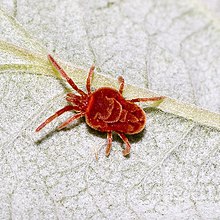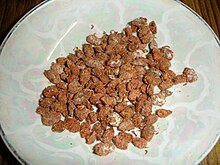Trombidiidae
| Trombidiidae Temporal range:
| |
|---|---|

| |
| Trombidium sp. | |
| Scientific classification | |
| Domain: | Eukaryota |
| Kingdom: | Animalia |
| Phylum: | Arthropoda |
| Subphylum: | Chelicerata |
| Class: | Arachnida |
| Order: | Trombidiformes |
| Superfamily: | Trombidioidea |
| Family: | Trombidiidae Leach, 1815[1] |
Trombidiidae, known as red velvet mites, true velvet mites,[2] or rain bugs, are arachnids found in soil litter known for their bright red color. Red velvet mites are active predators as grown adults but as early instars are often parasites on insects[3] and some arachnids. They are sometimes mistaken for spiders.
The pattern of stages is shared with that of other members of the Prostigmata: egg, pre-larva, larva, protonymph, deutonymph, tritonymph and adult (male or female). While adult true velvet mites are typically 4 mm (0.16 in) in length, some, such as the genus Dinothrombium, may reach up to 12 mm (0.47 in).[2] They usually have only one breeding cycle per year.[4]
One well known species from Europe, Asia, and North Africa is Trombidium holosericeum.[5] The systematics of this group has been in flux and many former subfamilies of this are now raised to families within the Trombidioidea.[4][6]
List of genera
According to Joanna Makol[7]
- Trombidiinae Leach, 1815
- Allothrombium Berlese, 1903 synonyme Corethrothrombium Oudemans, 1928 & Mongolothrombium Feider, 1973
- Andinothrombium Makol, 2007
- Andrethrombium Makol, 2007
- Arknotrombium Haitlinger, 2007
- Azaritrombium Saboori, Bagheri & Haddad, 2005
- Caenothrombium Oudemans, 1927
- Calctrombidium Haitlinger, 2003
- Clinotrombium Southcott, 1986
- Darjeelingia Makol, 2007
- Dinothrombium Oudemans, 1910
- Dolichothrombidium Feider, 1945
- Iranitrombium Saboori & Hajiqanbar in Saboori, Hajiqanbar & Irani-nejad 2003
- Mesothrobium Hirst, 1926 synonyme Austrothrombium Womersley, 1934
- Monotrombium Zhang in Zhang & Norbakhsh 1995
- Oskootrombium Saboori, Bagheri & Haddad 2006
- Paratrombium Bruyant, 1910
- Pollicotrombium Southcott, 1986
- Robauxthrombium Makol, 2007
- Ronaldothrombium Makol, 2007
- Trombidium Fabricius, 1775 synonyme Kaszabothrombium Fieder, 1973
- Variathrombium Robaux, 1969
- Wohltmannella Makol, 2007
- Xenothrombium Oudemans, 1927
Human use

The oil from the red velvet mite Trombidium grandissimum is used in traditional Indian medicine to treat paralysis.[8][9]
References
- ^ Leach, 1815 : A tabular view of the external characters of four classes of animals, which Linné arranged under Insecta; with the distribution of the genera composing three of these classes into orders, and descriptions of several new genera and species. Transactions of the Linnean Society of London, vol. 11, p. 306–400.
- ^ a b "Family Trombidiidae - true velvet mites - BugGuide.Net". bugguide.net. BugGuide. Retrieved 21 June 2019.
- ^ L. Conradt, S. A. Corbet, T. J. Roper, E. J. Bodsworth (2002) Parasitism by the mite Trombidium breei on four U.K. butterfly species. Ecological Entomology 27(6):651-659
- ^ a b Zhang, Zhi-Qiang (1998) Biology and ecology of trombidiid mites (Acari: Trombidioidea) Experimental & Applied Acarology 22:139-155 PDF
- ^ Mąkol, J.; Wohltmann, Andreas (2000). "A redescription of Trombidium holosericeum (Linnaeus, 1758) (Acari: Actinotrichida: Trombidioidea) with characteristics of all active instars and notes on taxonomy and biology". Annales Zoologici. 50 (1): 67–91.
- ^ Makol, Joanna (2007) Generic level review and phylogeny of Trombidiidae and Podothrombiidae (Acari: Actinotrichida: Trombidioidea) of the world. Annales Zoologici 57(1): 1-194
- ^ Makol, 2007 : Generic level review and phylogeny of Trombidiidae and Podothrombiidae (Acari: Actinotrichida: Trombidioidea) of the world. Annales Zoologici (Warsaw), vol. 57, n. 1, p. 1-194.
- ^ Oudhia, P. 1999b. Traditional medicinal knowledge about red velvet mite Trombidium sp. (Acari: Trombidiidae) in Chhattisgarh. Insect Environment 5(3):113. Archived 2011-06-07 at the Wayback Machine
- ^ https://www.thehindu.com/news/national/telangana/rare-breed-of-insects-in-huge-demand/article7349042.ece

